
Clupeiformes is the order of ray-finned fish that includes the herring family, Clupeidae, and the anchovy family, Engraulidae. The group includes many of the most important forage and food fish.

Herring are forage fish, mostly belonging to the family of Clupeidae.

Cheilodactylidae, commonly called morwongs but also known as butterfish, fingerfins, jackassfish, sea carp, snappers, and moki, is a family of marine ray-finned fish. They are found in subtropical oceans in the Southern Hemisphere. The common name "morwong" is also used as a name for several unrelated fish found in Australian waters, such as the painted sweetlips. The classification of the species within the Cheilodactylidae and the related Latridae is unclear.
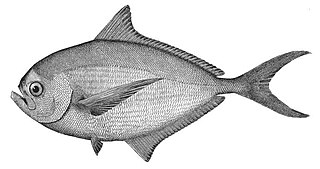
Pomfrets are scombriform fish belonging to the family Bramidae. The family currently includes 20 species across seven genera. Several species are important food sources for humans, especially Brama brama in South Asia. The earlier form of the pomfret's name was "pamflet", a word which probably ultimately comes from Portuguese pampo, referring to various fish such as the blue butterfish. The fish meat is white in color.

Sprat is the common name applied to a group of forage fish belonging to the genus Sprattus in the family Clupeidae. The term also is applied to a number of other small sprat-like forage fish. Like most forage fishes, sprats are highly active, small, oily fish. They travel in large schools with other fish and swim continuously throughout the day.
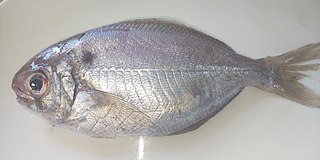
The Pacific rudderfish is a marine fish also known by such names as Japanese butterfish, melon seed, wart perch, ibodai or simply but ambiguously as butterfish.

The Australian herring, also known as the ruff, tommy ruff, or Australian ruff, is one of four Australasian fish species within the genus Arripis. It closely resembles its sister species, the Australian salmon, although it grows to a smaller size. Like the other members of its genus, it is found in cooler waters around the southern coast of Australia. It is not biologically related to the herring family Clupeidae.

The family Stromateidae or butterfish contains 15 species of ray-finned fish in three genera. Butterfishes live in coastal waters off the Americas, western Africa and in the Indo-Pacific.
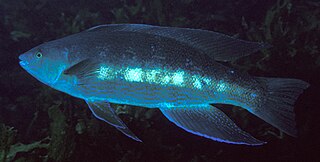
The Odacidae are a small family of ray-finned fishes commonly known as cales and weed whitings, formerly classified within the order Perciformes. They are related to the much larger families of the wrasses and parrotfish. More recent workers have classified this family within the order Labriformes, alongside the wrasses and parrotfishes, within the clade Percomorpha.

Odax pullus, known by the names greenbone, butterfish or its Māori language name rarī, is a species of ray-finned fish, a weed whiting from the family Odacidae, which is found around New Zealand. It is of minor importance to local commercial fisheries.

The bluefinned butterfish a species of marine ray-finned fish, a weed whiting from the family Odacidae, which is found only around Three Kings Islands about 80 km north of New Zealand. It is found in shallow reef areas where brown seaweed is abundant. This species can reach a length of 27 centimetres (11 in) SL. It is of minor importance to local commercial fisheries. Isolated individuals have been recorded elsewhere around the northern North Island.
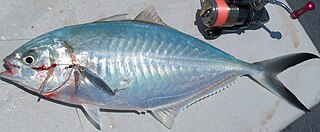
The herring scad, is a common species of tropical marine fish in the jack family Carangidae. The species inhabits the surface waters of coastal regions throughout the Indo-West Pacific region, feeding on a variety of crustaceans and small fishes. It is the largest fish of the scad genus Alepes, growing to a recorded length of 56 cm. The herring scad is identified among the genus Alepes by its more numerous and smaller scutes and the number of gill rakers on the first arch. It is of minor importance to fisheries throughout its range.

Scatophagus argus, the spotted scat, butterfish, mia mia, spotted butterfish or tiger scat, is a species of fish in the scat family Scatophagidae. It occurs in two basic color morphs which are called green scat and ruby or red scat. This fish is generally distributed around the Indo-Pacific region, to Japan, New Guinea, and southeastern Australia. They live in coastal muddy areas, including estuaries, mangroves, harbours, and the lower courses of rivers. They are popular aquarium fish.

An anchovy is a small, common forage fish of the family Engraulidae. Most species are found in marine waters, but several will enter brackish water, and some in South America are restricted to fresh water.
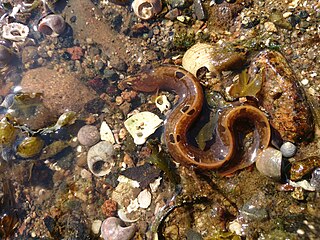
The rock gunnel, or butterfish, is a species of marine ray-finned fish belonging to the family Pholidae, the gunnels. This species is found in the coastal waters of the North Atlantic Ocean and in the Atlantic part of the Arctic Ocean.
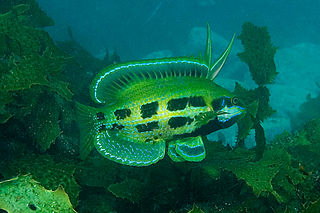
Heteroscarus acroptilus, the rainbow cale, is a species of weed whiting endemic to Australia where it is found in marine waters along the southern coast. It inhabits rocky reefs that have plentiful growth of brown algae and also in beds of seagrass, particularly those of the genus Posidonia. It occurs at depths of from 1 to 15 metres. This species grows to a length of 24 centimetres (9.4 in) SL. It can also be found in the aquarium trade. This species is the only known member of its genus.

The herring cale is a species of ray-finned fish, a weed whiting from the family Odacidae which is endemic to Australia where it is found along the southern and southeastern coast. It inhabits the surf zone, ranging to a depth of 30 m (98 ft) in rocky areas with plentiful growth of brown algae, which it feeds on. This species grows to a length of 51 cm (20 in) SL. This species is the only known member of the genus Olisthops, but it has frequently been placed in Odax instead.
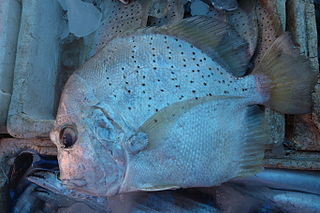
Drepane punctata, the butterfish, concertinafish, jetto, peppercorn, sickle-fish, silver moonfish, spotted batfish, spotted sicklefish, sicklefish or spotted spadefish, is a species of ray-finned fish belonging to the family Drepaneidae, the sicklefishes. This fish is found in the Indo-Pacific.

The spotbanded scat,(Selenotoca multifasciata), also known as the striped scat, banded scat, barred scat, butterfish, John Dory, Johnny Dory, old maid, Southern butter-fish or striped butterfish, is a species of ray-finned fish, belonging to the family Scatophagidae, the scats. They are found in the eastern Indian Ocean and southwestern Pacific Ocean.

The blue butterfish, is a species of pelagic fish in the genus Stromateus.



















